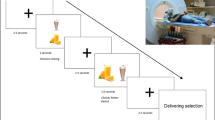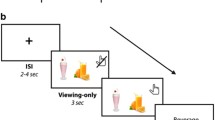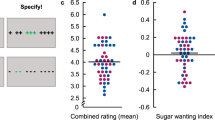Abstract
In the USA, Hispanics and African-Americans show elevated obesity, yet little is known about possible ethnic/racial differences in brain response during intake of palatable foods. To examine potential differences between non-Hispanic white (nHW) and racial/ethnic minority individuals, we used functional magnetic resonance imaging (fMRI) to assess brain response to intake of eucaloric milkshakes that were either high-sugar or high-fat and a calorie-free, tasteless control solution. Our sample included healthy-weight adolescents who identified as African-American and/or Hispanic (minority, n = 27) and non-Hispanic white (nHW, n = 106). Minority participants showed elevated response in the pre-/postcentral gyrus, precuneus, and left thalamus in response to the high-sugar milkshake compared to high-fat milkshake. To confirm these effects were not driven by differences in body mass or a function of unequal cell sizes, we performed the same analyses in minority participants and a randomly selected subsample of nHW participants (n = 27) that were matched on BMI percentile. Similar to the full sample, we observed an elevated ventral posterior thalamic response to high-sugar milkshake in minority participants. This effect held after controlling for self-reported sugar and fat intake. These results suggest that African-American and Hispanic groups may have elevated response to specifically high-sugar foods in regions of the brain associated with sensory processing, providing novel information regarding the possible neural underpinnings of the disproportional risk for obesity seen in African-American and Hispanic populations.

Similar content being viewed by others
References
Wang Y, Beydoun MA. The obesity epidemic in the United States—gender, age, socioeconomic, racial/ethnic, and geographic characteristics: a systematic review and meta-regression analysis. Epidemiol Rev. 2007;29:6–28.
Ogden CL, Carroll MD, Kit BK, Flegal KM. Prevalence of obesity and trends in body mass index among US children and adolescents, 1999-2010. JAMA. 2012;307:483–90.
Olds T, Maher C, Zumin S, Péneau S, Lioret S, Castetbon K, et al. Evidence that the prevalence of childhood overweight is plateauing: data from nine countries. Int J Pediatr Obes. 2011;6:342–60.
Wang CY, Gortmaker SL, Taveras EM. Trends and racial/ethnic disparities in severe obesity among US children and adolescents, 1976–2006. Int J Pediatr Obes. 2011;6:12–20.
Robbins JM, Mallya G, Polansky M, Schwarz DF. Prevalence, disparities, and trends in obesity and severe obesity among students in the Philadelphia, Pennsylvania, school district, 2006–2010. Child. Obes. Epidemic Why Are Our Child. Obese—And What Can We Do About It? CRC Press; 2015;29.
Datar A, Chung PJ. Changes in socioeconomic, racial/ethnic, and sex disparities in childhood obesity at school entry in the United States. JAMA Pediatr. 2015;169:696–7.
Frederick CB, Snellman K, Putnam RD. Increasing socioeconomic disparities in adolescent obesity. Proc Natl Acad Sci USA. 2014;111:1338–42.
Curtis DS, Fuller-Rowell TE, Doan SN, Zgierska AE, Ryff CD. Racial and socioeconomic disparities in body mass index among college students: understanding the role of early life adversity. J Behav Med. 2016:1–10.
Carroll-Scott A, Gilstad-Hayden K, Rosenthal L, Peters SM, McCaslin C, Joyce R, et al. Disentangling neighborhood contextual associations with child body mass index, diet, and physical activity: the role of built, socioeconomic, and social environments. Soc Sci Med. 2013;95:106–14.
Babbs RK, Sun X, Felsted J, Chouinard-Decorte F, Veldhuizen MG, Small D. Decreased caudate response to milkshake is associated with higher body mass index and greater impulsivity. Physiol. Behav. 2013.
Frank GKW, Reynolds JR, Shott ME, Jappe L, Yang TT, Tregellas JR, et al. Anorexia nervosa and obesity are associated with opposite brain reward response. Neuropsychopharmacology [Internet]. 2012;37:2031–46. Available from: http://www.ncbi.nlm.nih.gov/pmc/articles/PMC3398719/pdf/npp201251a.pdf.
Green E, Jacobson A, Haase L, Murphy C. Reduced nucleus accumbens and caudate nucleus activation to a pleasant taste is associated with obesity in older adults. Brain Res. [Internet]. 2011;1386:109–17. Available from: http://www.ncbi.nlm.nih.gov/pmc/articles/PMC3086067/pdf/nihms284828.pdf.
Stice E, Spoor S, Bohon C, Veldhuizen MG, Small DM. Relation of reward from food intake and anticipated food intake to obesity: a functional magnetic resonance imaging study. J Abnorm Psychol. 2008;117:924–35.
Stice E, Yokum S, Burger KS, Epstein LH, Small DM. Youth at risk for obesity show greater activation of striatal and somatosensory regions to food. J Neurosci. 2011;31:4360–6.
Geha PY, Aschenbrenner K, Felsted J, O’Malley SS, Small DM. Altered hypothalamic response to food in smokers. Am J Clin Nutr. 2013;97:15–22.
Bolton-Smith C, Woodward M. Dietary composition and fat to sugar ratios in relation to obesity. Int J Obes Relat Metab Disord. 1994;18:820–8.
Blundell JE, Macdiarmid JI. Fat as a risk factor for overconsumption. J Am Diet Assoc. 1997;97:S63–9.
Ludwig DS, Peterson KE, Gortmaker SL. Relation between consumption of sugar-sweetened drinks and childhood obesity: a prospective, observational analysis. Lancet. 2001;357:505–8.
McGloin AF, Livingstone MBE, Greene LC, Webb SE, Gibson JMA, Jebb SA, et al. Energy and fat intake in obese and lean children at varying risk of obesity. Int J Obes. [Internet]. 2002;26:200–7. Available from: http://www.nature.com/ijo/journal/v26/n2/pdf/0801883a.pdf.
Drewnowski A. Obesity, diets, and social inequalities. Nutr Rev. 2009;67:S36–9.
Hall KD, Bemis T, Brychta R, Chen KY, Courville A, Crayner EJ, et al. Calorie for calorie, dietary fat restriction results in more body fat loss than carbohydrate restriction in people with obesity. Cell Metab. 2015;22:427–36.
Dalle Grave R, Calugi S, Gavasso I, El Ghoch M, Marchesini G. A randomized trial of energy-restricted high-protein versus high-carbohydrate, low-fat diet in morbid obesity. Obesity (Silver Spring). 2013;21:1774–81.
Stice E, Burger KS, Yokum S. Relative ability of fat and sugar tastes to activate reward, gustatory, and somatosensory regions. Am J Clin Nutr. [Internet]. 2013;98:1377–84. Available from: http://ajcn.nutrition.org/content/98/6/1377.abstract.
(US) NC for HS. CDC growth charts: United States. 2000.
Flint A, Raben A, Blundell JE, Astrup A. Reproducibility, power and validity of visual analogue scales in assessment of appetite sensations in single test meal studies. Int J Obes. 2000;24:38.
Block G, Subar AF. Estimates of nutrient intake from a food frequency questionnaire: the 1987 National Health Interview Survey. J Am Diet Assoc. 1992;92:969.
Cox RW. AFNI: software for analysis and visualization of functional magnetic resonance neuroimages. Comput Biomed Res. 1996;29:162–73.
Eklund A, Nichols T, Knutsson H. Can parametric statistical methods be trusted for fMRI based group studies? arXiv Prepr. arXiv1511.01863. 2015.
Bohon C. Brain response to taste in overweight children: a pilot feasibility study. PLoS One. 2017;12:e0172604.
Geliebter A, Ladell T, Logan M, Schweider T, Sharafi M, Hirsch J. Responsivity to food stimuli in obese and lean binge eaters using functional MRI. Appetite. 2006;46:31–5.
Behrens TEJ, Johansen-Berg H, Woolrich MW, Smith SM, Wheeler-Kingshott CAM, Boulby PA, et al. Non-invasive mapping of connections between human thalamus and cortex using diffusion imaging. Nat Neurosci. 2003;6:750–7.
Augustine JR. Circuitry and functional aspects of the insular lobe in primates including humans. Brain Res Rev. 1996;22:229–44.
Samuelsen CL, Gardner MPH, Fontanini A. Thalamic contribution to cortical processing of taste and expectation. J Neurosci. 2013;33:1815–27.
Burger KS, Stice E. Frequent ice cream consumption is associated with reduced striatal response to receipt of an ice cream-based milkshake. Am J Clin Nutr. 2012;95:810–7.
Burger KS, Stice E. Neural responsivity during soft drink intake, anticipation, and advertisement exposure in habitually consuming youth. Obesity. 2013;22:441–50.
Stice E, Spoor S, Bohon C, Small DM. Relation between obesity and blunted striatal response to food is moderated by TaqIA A1 allele. Science (80-. ). [Internet]. 2008;322:449–52. Available from: http://www.ncbi.nlm.nih.gov/pmc/articles/PMC2681095/pdf/nihms100847.pdf.
Nolan-Poupart S, Veldhuizen MG, Geha P, Small DM. Midbrain response to milkshake correlates with ad libitum milkshake intake in the absence of hunger. Appetite. [Internet]. 2013;60:168–74. Available from: http://www.sciencedirect.com/science/article/pii/S0195666312004035.
Author information
Authors and Affiliations
Corresponding author
Ethics declarations
This study was funded by NIH grant DK092468. The authors declare no conflicts of interest. All procedures performed in studies involving human participants were in accordance with the ethical standards of the institutional and/or national research committee and with the 1964 Helsinki declaration and its later amendments or comparable ethical standards. Informed consent was obtained from all individual participants included in the study.
Rights and permissions
About this article
Cite this article
Gilbert, J.R., Stice, E. & Burger, K.S. Elevated Thalamic Response to High-Sugar Milkshake in Ethnic and Racial Minorities. J. Racial and Ethnic Health Disparities 5, 580–587 (2018). https://doi.org/10.1007/s40615-017-0403-8
Received:
Revised:
Accepted:
Published:
Issue Date:
DOI: https://doi.org/10.1007/s40615-017-0403-8




